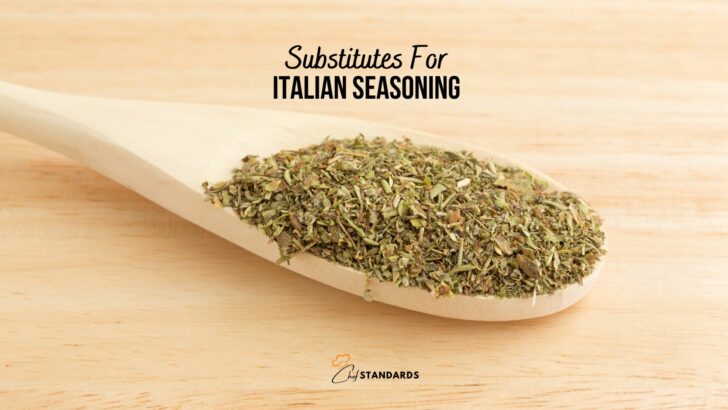Italian seasoning is a combination of different dried herbs including basil, oregano, thyme, marjoram, rosemary, and sage. In my kitchen, it is an ESSENTIAL ingredient that I preferably use to spice up soups and stews.
When I ran out of it, I did my research and found some worthy substitutes for Italian seasoning. I must admit that it took me a while to find the right Italian seasoning alternatives that go perfectly with any dish.
If you’re facing the same problem (read: if you don’t have any Italian seasoning on hand), or want to try something new, below you’ll find 13 great substitutes including an aromatic, homemade alternative.
DID YOU KNOW? Italian seasoning has been used in cooking for centuries, but its roots are a bit puzzling. Yet, the most popular opinion is that it originated somewhere along the Mediterranean as the ancient Greeks and Romans experimented with special blends for flavoring.
SEASONING BLEND SUBSTITUTES
1. Herbes de Provence
Herbes de Provence is an aromatic blend of dried Provençal herbs and spices. This blend originated in the Provence region of Southern France, so it’s commonly related to French cuisine. Here’s why it is a great substitute for Italian seasoning:
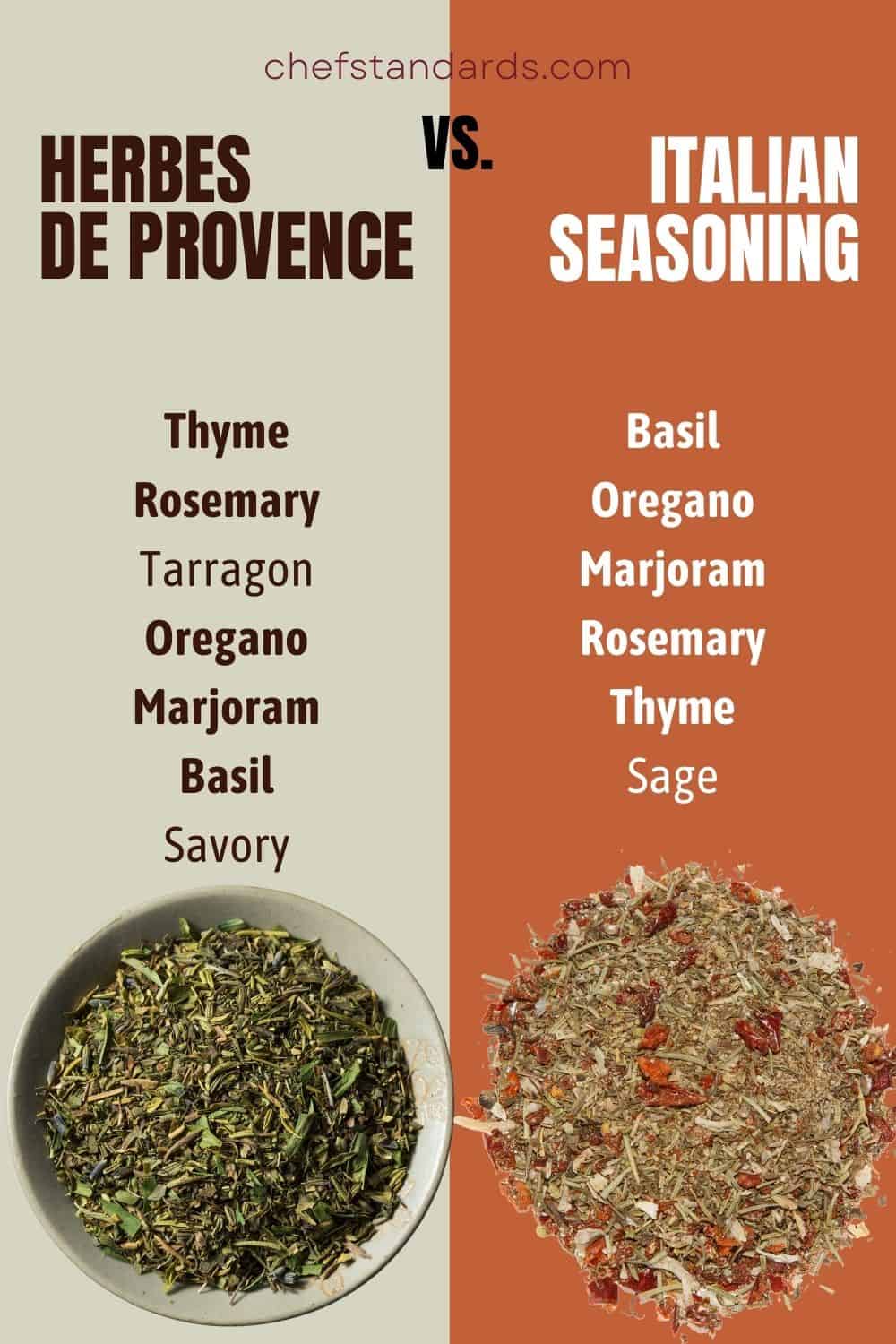
Pros
• Texture: Both Herbes de Provence blend and Italian seasoning are made of dry herb mixture.
• Flavor: Herbes de Provence blend has a similar flavor profile to Italian seasoning. Their base flavor is herbal and they have earthy and slightly sweet undertones.
• Availability: Both Herbes de Provence blend and Italian seasoning can be found in grocery stores, supermarkets, and online shopping websites.
• Price: Herbes de Provence blend is a somewhat cheaper alternative than Italian seasoning. 1 pound of Herbes de Provence blend costs around $27, whereas 1 pound of Italian seasoning costs around $31.
Cons
• Ingredients: The key difference between two seasonings is that Herbes de Provence doesn’t contain any sage as Italian seasoning does. Also, Herbes de Provence blend contains two additional ingredients: tarragon and savory.
How To Use Herbes de Provence
Herbes de Provence blend is best used with stews, soups, rice, quinoa dishes, and in sauces, meat, seafood and salad dressings. This blend also goes well with wrap fillings and veggies.
2. Herbes de la Garrigue
Herbes de la Garrigue is a herb blend from southwestern France. This alternative is perfect for those who want to preserve the flavors of Italian food.
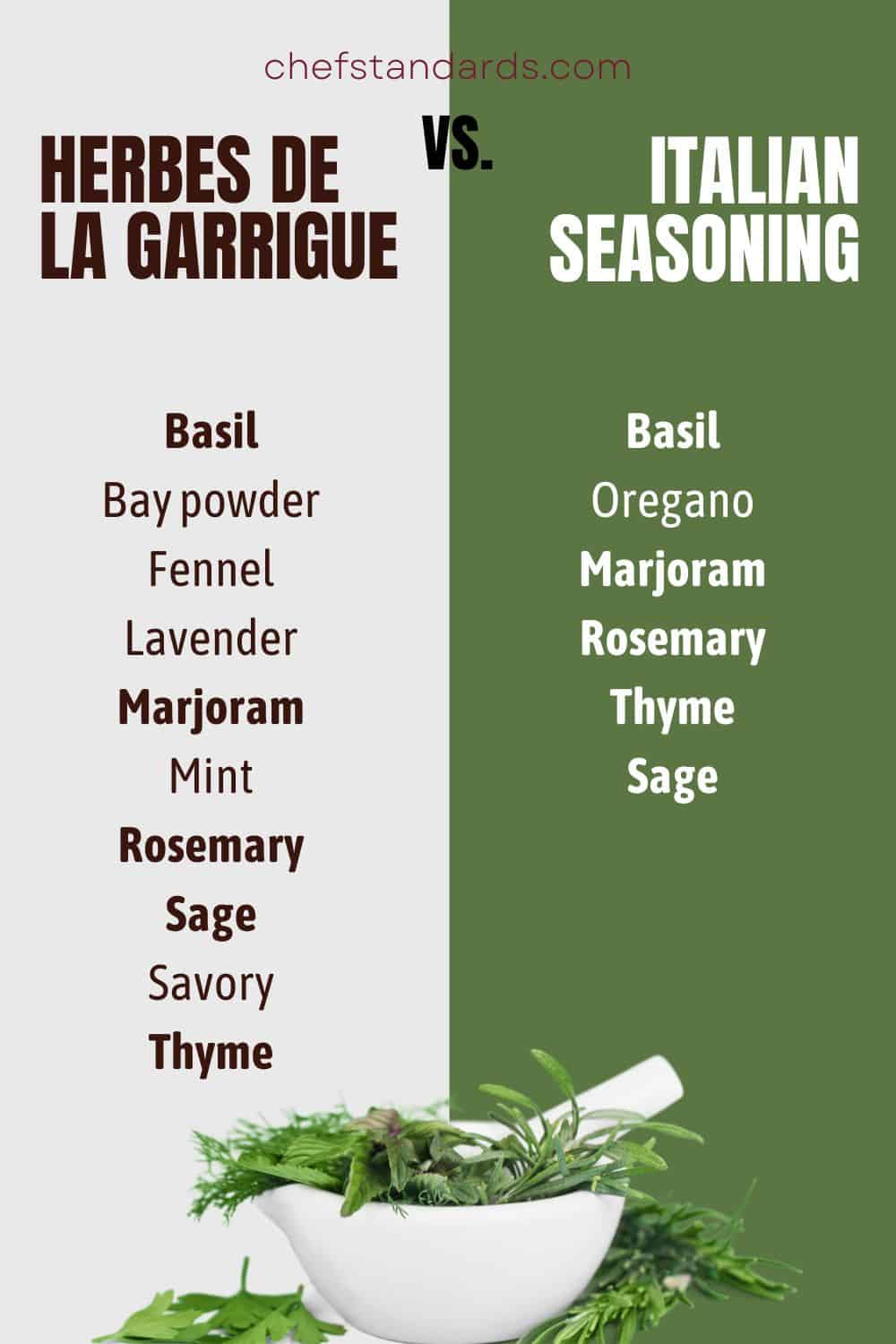
Pros
• Texture: Both Herbes de la Garrigue blend and Italian seasoning are made of dry herb mixture.
• Flavor: Herbes de la Garrigue has a similar flavor profile to Herbes de Provence blend and Italian seasoning. The base flavor of all three seasonings is herbal with earthy and slightly sweet undertones.
• Availability: Both Herbes de la Garrigue blend and Italian seasoning can be found in grocery stores, supermarkets, and online shopping websites.
Cons
• Ingredients: Herbes de la Garrigue doesn’t contain any oregano. Also, Herbes de la Garrigue blend contains five additional ingredients: bay powder, fennel, lavender, mint, and savory.
• Price: Herbes de la Garrigue blend is a more expensive alternative than Italian seasoning. 7 ounces of high quality Herbes de la Garrigue blend costs around $50, whereas 1 pound of Italian seasoning costs around $31.
How To Use Herbes de la Garrigue
Herbes de la garrigue is best used with grilled meats, home baked breads, stews, beans, sausage, rice and sauces.
3. Pizza seasoning
Pizza seasoning gives you that pizza taste without having to make a pizza. In my opinion, it is the best thing since sliced bread, and a great alternative to Italian seasoning (especially if you prefer a slightly spicier flavor profile).
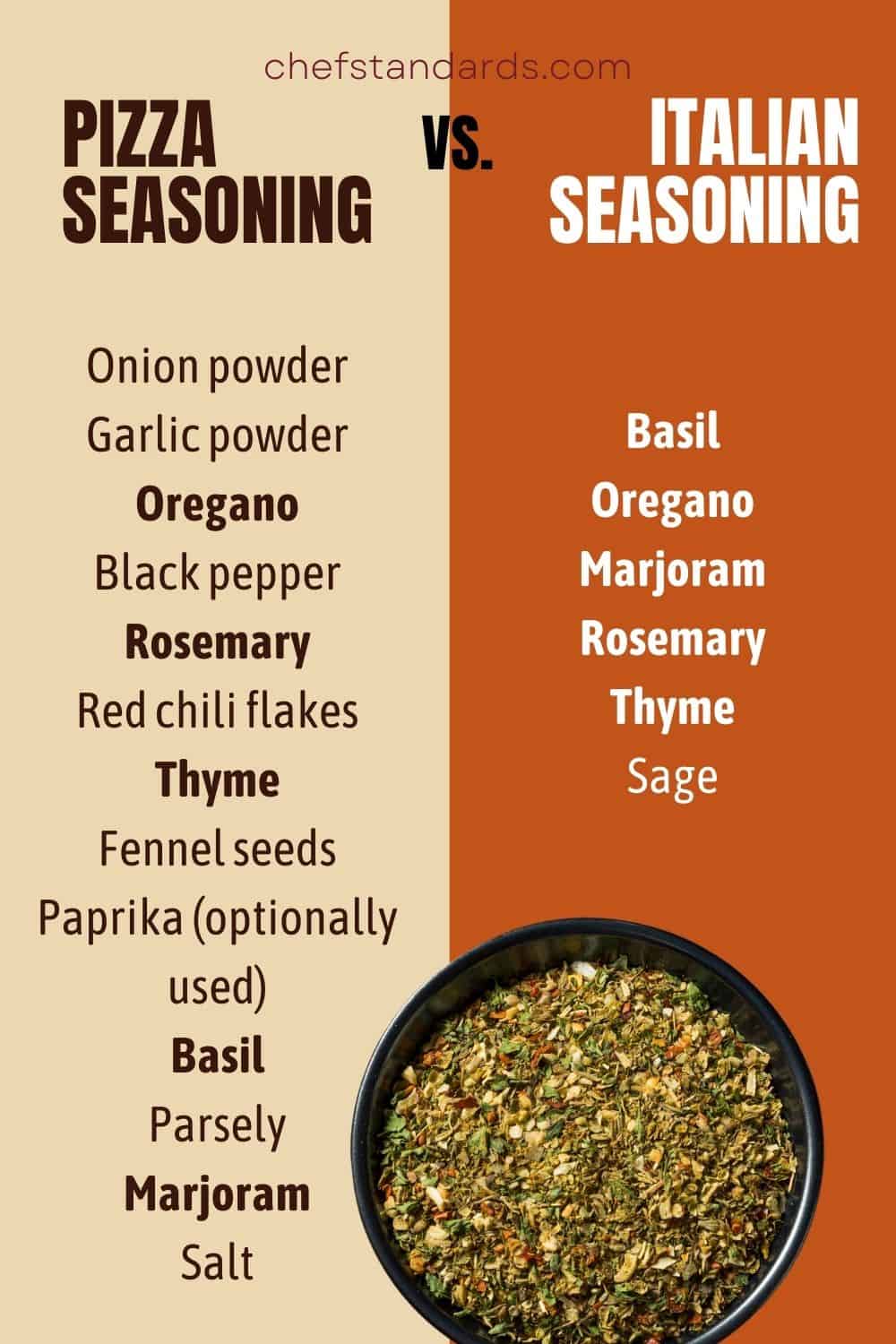
Pros
• Texture: Both pizza seasoning and Italian seasoning have a dry and coarse texture.
• Availability: Both pizza seasoning and Italian seasoning are widely available in grocery stores, supermarkets and online shopping sites.
• Price: Pizza seasoning and Italian seasoning have the same price range. 1 pound of pizza seasoning costs around $31, and 1 pound of Italian seasoning also costs around $31.
Cons
• Flavor: Pizza seasoning has salty, herbal, earthy, and umami flavor notes with a mild heat. It is spicier than Italian seasoning, which can also be seen as an advantage if you prefer a spicier flavor profile.
• Ingredients: Apart from other ingredients, pizza seasoning doesn’t contain any sage that can be found in Italian seasoning. Also, pizza seasoning contains eight additional ingredients: onion powder, garlic powder, black pepper, red chili flakes, fennel seeds, paprika, parsely, and salt.
How To Use Pizza Seasoning
Pizza seasoning is best used in pizzas, soups, and as a flavor enhancer in sauces. It is also a complimentary ingredient on roasted veggies and meats, and in bread doughs (especially garlic bread).
4. Creole seasoning
Spicy Creole seasoning was invented by Anthony Chachere, an American businessman and chef best known as the founder of Tony Chachere’s Creole Foods seasonings and ingredients brand.
DID YOU KNOW? The Creole style of cooking began in New Orleans and is derived from French, Spanish, Italian, American Indian, African, and other ethnic groups.
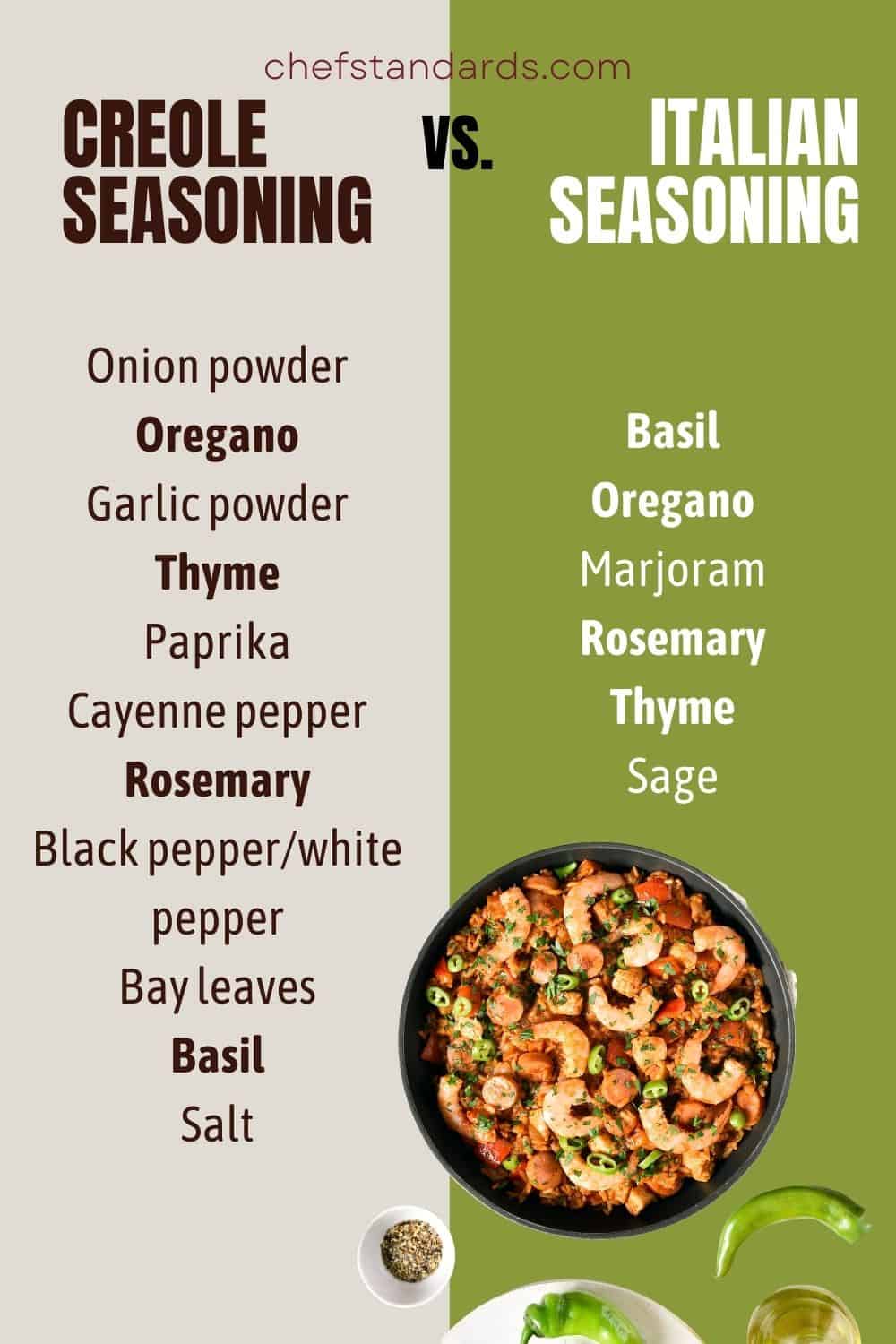
Pros
• Texture: Both Creole seasoning and Italian seasoning have a dry and pulverized texture.
• Availability: Both Creole seasoning and Italian seasoning are widely available in grocery stores, supermarkets and online shopping sites.
• Price: Creole seasoning is a cheaper alternative than Italian seasoning. 1 pound of Creole seasoning costs around $24, whereas 1 pound of Italian seasoning costs around $31.
Cons
• Flavor: Creole seasoning is a spicier alternative than Italian seasoning. Creole seasoning is earthy and savory with spicy, herbal, salty, and umami undertones, whereas Italian seasoning is more herbal with earthy and subtle sweet undertones.
• Ingredients: Creole seasoning has more ingredients than Italian seasoning and it doesn’t contain any marjoram and sage. Creole seasoning contains seven additional ingredients: onion powder, garlic powder, paprika, black pepper/white pepper, cayenne pepper, bay leaves, and salt.
How To Use Creole Seasoning
Creole seasoning is widely used as a seasoning for meat, shrimp, crawfish, and in sauces, rice, marinades, soups, and stews. You can also blend Creole seasoning with butter to make Creole Butter Mixture.
5. Greek seasoning
Italians have been using oregano, basil, thyme, and garlic for centuries to season their food. But the Greeks have their own twist on the flavor profile with dill weed, black pepper and parsley that create an even more distinct taste.

Pros
• Texture: Both Italian seasoning and Greek seasoning have a dry and coarse texture.
• Price: Greek seasoning is a slightly cheaper alternative than Italian seasoning. 1 pound of Greek seasoning costs around $24, while 1 pound of Italian seasoning costs around $31.
Cons
• Flavor: Greek seasoning has a deeper and more intense flavor than Italian seasoning (which can also be an advantage to some). Greek seasoning has savory, spicy, warm, and earthy undertones, whereas Italian seasoning is more herbal with earthy and subtle sweet undertones.
• Ingredients: Greek seasoning has much more ingredients than Italian seasoning. In fact, these two seasonings have only two ingredients in common: basil and marjoram.
• Availability: Greek seasoning can be found in leading supermarkets and online shopping websites, while Italian seasoning is widely available in grocery stores, online stores, and supermarkets.
How To Use Greek Seasoning
You can use Greek seasoning for rice dishes, in marinades, to make creamy dips, or you can mix it into salads and salad dressings. This seasoning can also be used in various dishes made with pork, shrimp, lamb, chicken, etc.
6. Cajun seasoning
Cajun seasoning is widely known as a Southern American spice, but it also has its roots in rural French, Spanish, and African cooking. This spicy seasoning is typically reddish-brown in color.
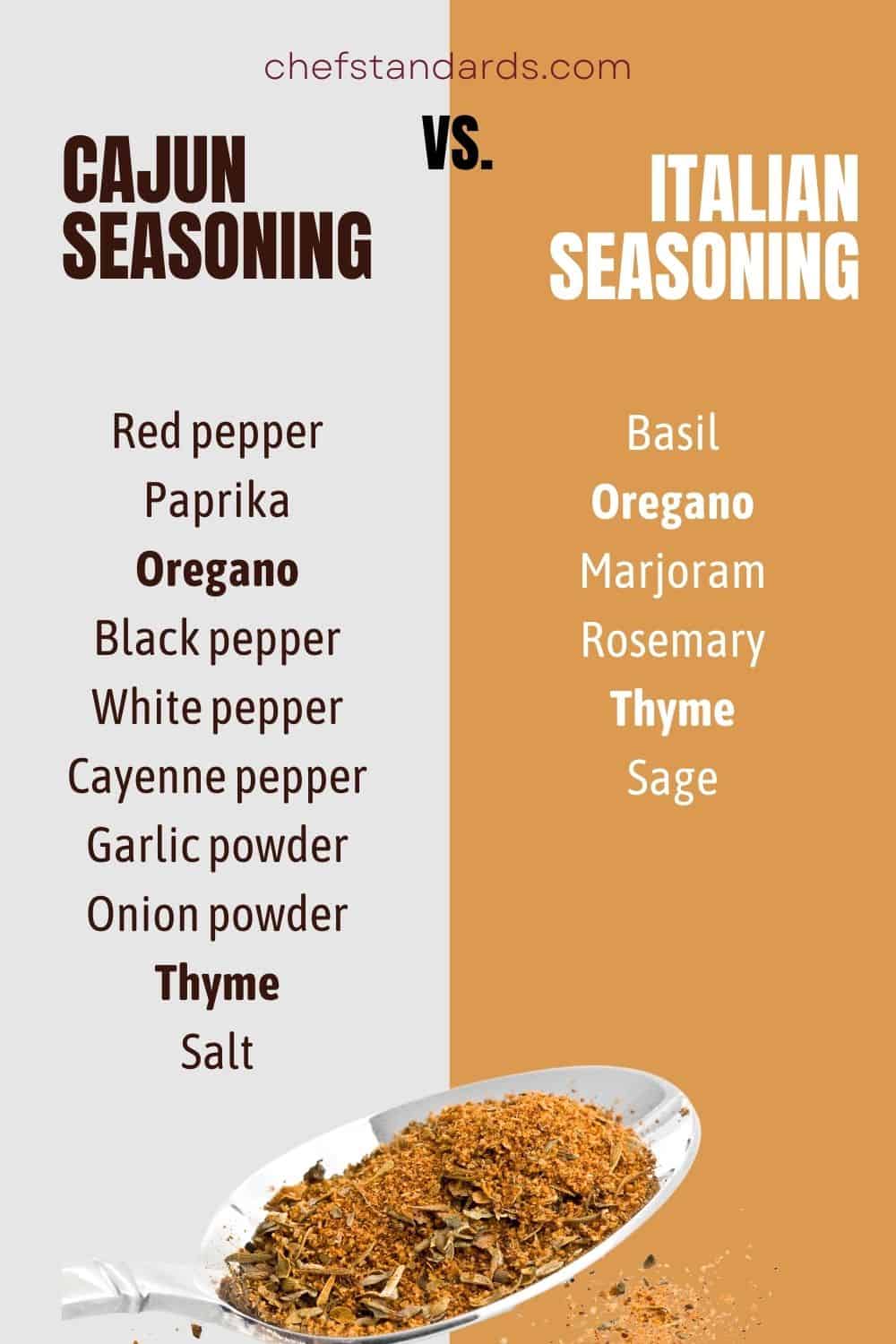
Pros
• Texture: Both Cajun seasoning and Italian seasoning have a dry and coarse texture.
• Availability: Both Cajun seasoning and Italian seasoning are widely available in grocery stores, supermarkets and online shopping sites.
• Price: Cajun seasoning is a somewhat cheaper alternative than Italian seasoning. 1 pound of Cajun seasoning costs around $26, whereas 1 pound of Italian seasoning costs around $31.
Cons
• Flavor: Cajun seasoning has a hot and spicy base tone, whereas Italian seasoning is more herbal. Cajun seasoning is sharp, intense, and spicy with earthy, umami undertones. Evidently, it is spicier than Italian seasoning, which can also be seen as an advantage if you prefer a spicier flavor profile.
• Ingredients: Cajun seasoning and Italian seasoning have only two ingredients in common: oregano and thyme. Furthermore, Cajun seasoning contains eight additional ingredients: onion powder, garlic powder, black pepper, white pepper, red pepper, paprika, cayenne pepper, and salt.
How To Use Cajun Seasoning
Cajun seasoning is primarily used to season meat, rice, fries, crackers, roasted nuts, fish, and other seafood. It is also used on roasted potatoes and various vegetables (onions, eggplant…) as well as in sauces, soups, and stews. Additionally, here are some great Cajun seasoning substitutes for you to try.
HERB AND SPICE SUBSTITUTES
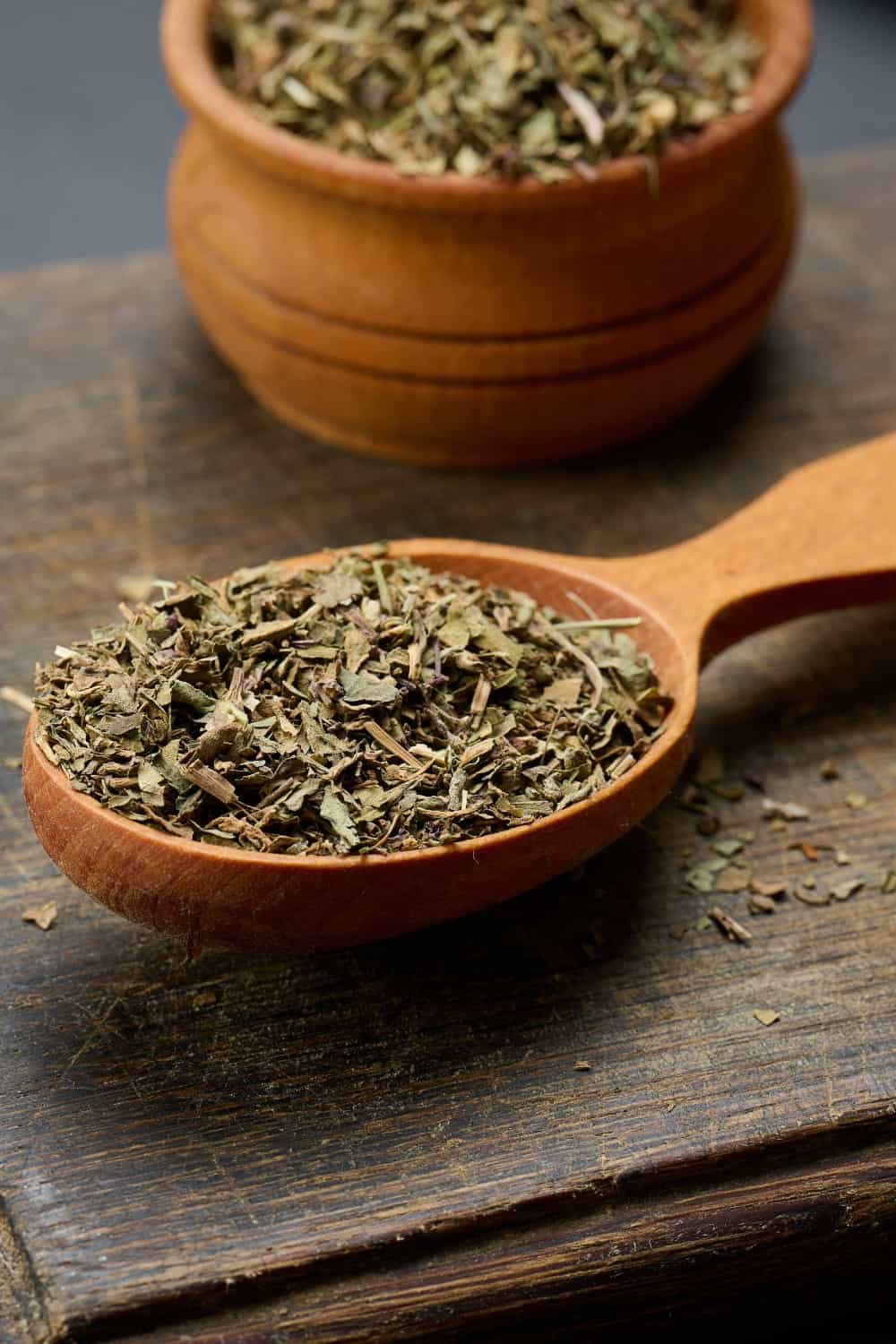
1. Dried basil + oregano
Basil and oregano are the key ingredients of Italian seasoning mix, so you can use these two herbs as an alternative to Italian seasoning.
Basil has a savory and sweet flavor with minty undertones, whereas oregano has a slightly bitter, pungent flavor with earthy and minty notes. Use equal amounts of both herbs and your substitute for Italian seasoning is ready!
2. Dried basil + oregano + thyme
Thyme is a sweet herb with floral and peppery hints. Basil, oregano, and thyme have different flavors with the same minty undertone which makes them a perfect substitute for Italian seasoning.
For a perfect Italian seasoning substitute, use the following amounts of herbs:
• 1 teaspoon of oregano
• ½ teaspoon of thyme
• ½ teaspoon of basil
3. Use a single Italian dried herb
If you can’t find (or you don’t have) the right blend of herbs and spices, then you can use a single Italian dried herb such as oregano, basil, marjoram, rosemary, thyme, or sage.
NOTE: Be mindful of the type of dish you’re preparing. For example, if you’re making pizza, then oregano is the best ‘herb of choice’. On the other hand, if you’re preparing pork, then you cannot go wrong with good old rosemary.
4. Cayenne pepper
Cayenne pepper is a type of chili pepper. Both Cayenne pepper and Cajun seasoning are great alternatives for Italian seasoning. You can use Cayenne pepper as a substitute for cajun seasoning.
Cayenne pepper is known for its spicy spicy flavor with sweet and earthy undertones. It is primarily used in soups, sauces, and stews.
5. Fresh Italian seasoning herbs
Italian seasoning is originally made of DRIED herbs, but if you have access to some FRESH herbs in your garden (or in a supermarket), then this can be your Italian seasoning alternative.
Contrary to fresh herbs, dried herbs have a more concentrated flavor. Therefore, you should use 1 ½ part of fresh herbs for 1 part of dried herbs.
It would be best if you had all fresh herbs that are found in Italian seasoning, but it’s also okay if you don’t. Feel free to add all of them or the one(s) you have from the following ingredients: basil, oregano, marjoram, rosemary, thyme, and sage.
6. Other herb and spice blends
Many other herb and spice blends can be used as substitutes for Italian seasoning, such as those that include basil, oregano, thyme, marjoram, rosemary, etc.
Therefore, look in your pantry and see if you have any spice or herb blends left, which you can use as a substitute for Italian seasoning. Find what you like and mix it together, or you can make your own homemade Italian seasoning!
Homemade Italian Seasoning Recipe
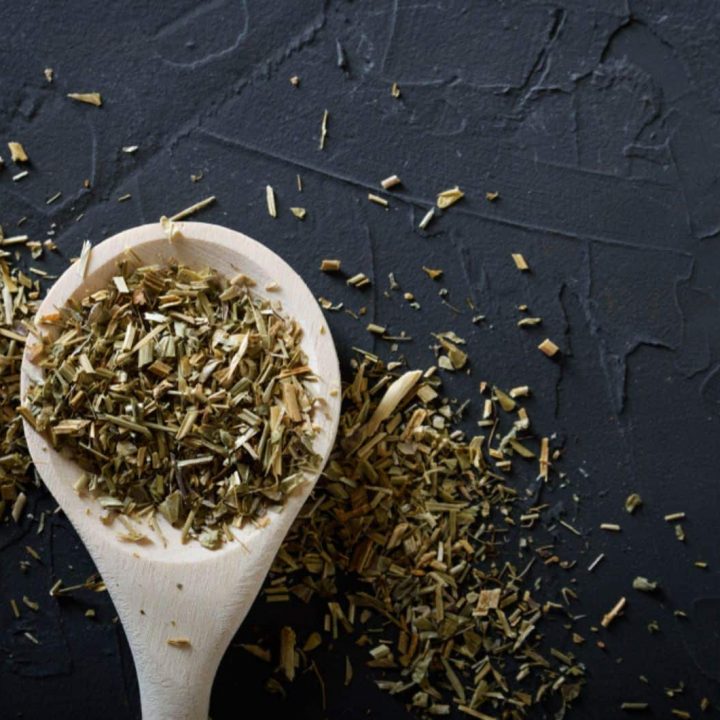
Homemade Italian Seasoning
The recipe for homemade Italian seasoning is simple, and you can use it in various dishes.
Ingredients
- 1 tablespoon dried oregano
- 2 teaspoons dried basil
- 2 teaspoons dried thyme (not ground)
- 1 teaspoon dried sage
- ½ teaspoon dried rosemary
- 1 teaspoon dried marjoram
Instructions
- Combine all ingredients in a small bowl, then pour into an air-tight container.
- Store it in a cool, dark place for six months to three years.
Notes
You can also add some fennel seeds, pepper, onion powder, parsley, etc. All these flavors will blend in perfectly.
How To Use Homemade Italian Seasoning
You can use homemade Italian seasoning in pizza, pasta, spaghetti, sauces, soups, stews, salad dressings, you name it.
You can also use it when making burgers, meatballs, or dishes containing vegetables. My favorite is dipping sauce made of Italian seasoning, olive oil, and some crushed red pepper flakes.
What NOT TO USE As An Italian Seasoning Substitute
Any spice blend made of warm spices is not a good alternative for Italian seasoning because it doesn’t contain that herbal flavor we’re looking for.
Here are a few examples of warm spices you should avoid when looking for an Italian seasoning substitute:
• Nutmeg
• Cinnamon
• Cumin seeds
• Mace
• Cloves
• Coriander
Any seasoning that contains more warm spices than dried herbs should be avoided. If you can’t find the right spice blend, it is better to use a single Italian dried herb, such as oregano or basil. Or you can always make your own Italian seasoning.
Did You Find The Right Italian Seasoning Substitute?
I hope the above list helped you find the best replacement(s) for Italian seasoning according to your dish and preferences.
Remember, it’s best to use a single Italian dried herb rather than seasoning blends that contain more warm spices than dried herbs. Happy cooking!


